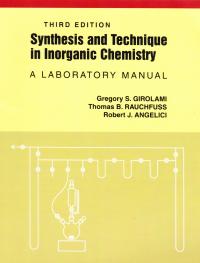Synthesis and Technique in Inorganic Chemistry
Synthesis and Technique in Inorganic Chemistry
By: Gregory S. Girolami, Thomas Rauchfuss, Robert Angelici
This well-known laboratory manual introduces students to modern synthetic and instrumental techniques currently used in inorganic chemistry.
For all sales outside of the United States, please contact Felicity Henson, fhenson@aip.org
Title information
Previously by Angelici, this laboratory manual for an upper-level undergraduate or graduate course in inorganic synthesis has for many years been the standard in the field. In this newly revised “third edition,” the manual has been extensively updated to reflect new developments in inorganic chemistry. Twenty-three experiments are divided into five sections: solid state chemistry, main group chemistry, coordination chemistry, organometallic chemistry, and bioinorganic chemistry. The included experiments are safe, have been thoroughly tested to ensure reproducibility, are illustrative of modern issues in inorganic chemistry, and are capable of being performed in one or two laboratory periods of three or four hours. Because facilities vary from school to school, the authors have included a broad range of experiments to help provide a meaningful course in almost any academic setting. Each clearly written & illustrated experiment begins with an introduction that highlights the theme of the experiment, often including a discussion of a particular characterization method that will be used, followed by the experimental procedure, a set of problems, a listing of suggested Independent Studies, and literature references.
Introduction
Safety
Laboratory Procedures
Research Notebook
Standard References
Part I. Solid State Chemistry
Experiment 1--High-Temperature Synthesis of the Superconductor YBa2Cu3O7
Tube Furnace Preparation
Superconductivity
Iodometric Titrations
Experiment 2--The Layered Solids VOPO4(H2O)2 and VO(HPO4)(H2O)0.5
Powder X-Ray Diffraction
Oxidation of Alcohols to Ketones
Experiment 3--The Molecular Sieve Zeolite-X
Sol-gel Synthesis
High Pressure Synthesis
Ion Exchange in Microporous Solids
Part II. Main Group Chemistry
Experiment 4--The Borane-Amine Adduct BH3NH2C(CH3)3
Lewis Acids and Bases
Experiment 5--Buckminsterfullerene, C60, and Its Electrochemistry
Soxhlet Extraction
Cyclic Voltammetry
Experiment 6--Vacuum-Line Synthesis of GeH4
Vacuum Line and Trap-to-Trap Purification
Vapor Pressure and Molecular Weight Determination of a Volatile Compound
Gas Phase IR Spectroscopy
Experiment 7--Tin Chemistry: Coordination Complexes and Organometallic Derivatives
NMR Spectroscopy
Linkage Isomerism
Experiment 8--Synthesis of (C6H5)2PCH2CH2P(C6H5)2 in Liquid Ammonia
Synthesis in Liquid Ammonia
Experiment 9--Electrolytic Synthesis of K2S2O8
Electrolytic Preparation
Part III. Coordination Chemistry
Experiment 10--Ion Exchange Separation of Chromium Complexes
Ion Exchange Chromatography
Experiment 11--Metal-Metal Quadruple Bonds
Molecular Orbital Theory
Experiment 12--The Magnetic Susceptibility of Mn(acac)3
Magnetism of Transition Metal Complexes
The Gouy Method
The Evans Methods
Experiment 13--Cobalt Ammines and their Ligand Substitution Kinetics
Conductivity of Ionic Complexes
Kinetics of Aquation of [Co(NH3)5Cl]2+
Experiment 14--Optical Resolution of Co(en)33+
Separation of Diastereomers by Crystallization
Optical Rotations
Suction Filtration
Experiment 15--Metal Dithiolenes and the Use of Quaternary Ammonium Salts
Quaternary Ammonium Salts
Part IV. Organometallic Chemistry
Experiment 16--The Metal-Arene Complex [1,3,5-C6H3(CH3)3]Mo(CO)3
IR Spectra of Metal Carbonyls
Experiment 17--Organo-iron Chemistry: (C5H5)2Fe2(CO)4 and (C5H5)Fe(CO)2(CH3)
Schlenk Line Synthesis
Infrared Spectra of Solutions
Experiment 18--The Metal Carbonyl Cluster Fe3(CO)12
Mass Spectrometry
Experiment 19--Microscale Synthesis of Vaska's Complex
Microscale Synthesis
Solid State IR Spectra
Experiment 20--The Air-Sensitive Sandwich Complex Nickelocene
Glove Bag Manipulations
Sublimation
Part V. Bioinorganic Chemistry
Experiment 21--Cobaloximes: Models of Vitamin-B12 Coenzymes
Enzyme Models
Experiment 22--Amino Acid Complexes: Stability Constants of Ni(glycinate)n(2 - n)+
Amino Acid Chemistry
pH Titrations
pKa and Successive Stability Constant Determination
Experiment 23--Bioinorganic Coordination Chemistry: Copper (II) Tetraphenylporphyrinate
Porphyrin Chemistry
Thin-Layer Chromatography
Column Chromatography
Notes to the Instructor
Appendices
NMR and Mass Spectra
Index
|
“Each experiment is well chosen and collectively they present a sufficiently broad spectrum of synthesis and compound characterization techniques to provide an excellent education for any student who completes them…The writing style is clear and concise and at a level that advanced undergraduate students can clearly comprehend. It is highly recommended as a textbook for a one-semester advanced inorganic synthesis course.” “This is an excellent update to a classic inorganic chemistry laboratory text. One of the strengths of this book is that there is something here for everyone. The experiments described in the third edition illustrate a wide variety of topics in inorganic chemistry ranging from classic coordination chemistry to more recent advances in the fields of organometallic, solid state, and bioinorganic chemistry.” |

